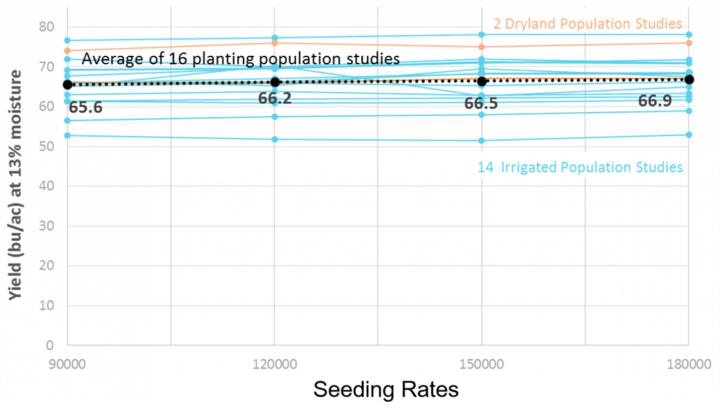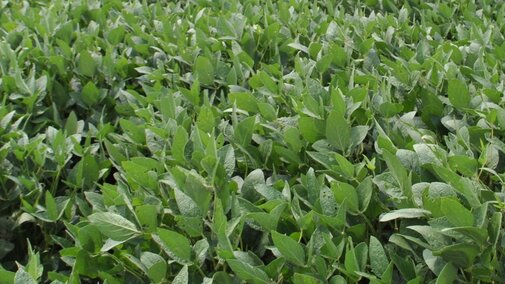In 2006, a group of farmers gathered in York for a discussion about on-farm research projects for the coming year. They were looking at ways to reduce input costs without affecting yield. One question asked was “What is the effect of seeding rates on soybean yields?” To look at the question several farmers chose to try a project with four seeding rates (90K, 120K, 150K, and 180K seeds/acre) in 30-inch row spacings.
Ten years later, the research continues with the same results: reducing soybean seeding rates from 180,000 or 150,000 seeds/acre to 120,000 seeds/acre doesn’t statistically reduce yields in 30-inch rows in silty clay loam and silt loam soils in south-central and southeastern Nebraska. Results of 16 studies showed for seeding rates of 180K, 150K, and 120K seeds per acre, average yields were 66.9, 66.5, and 66.2 bu/ac, respectively (Figure 1).
The dataset for this study includes:
- The latest soybean varieties as the research was conducted from 2006-2016.
- Erect and bushy type varieties in growth architecture.
- Higher and lower yielding situations.
- Fourteen irrigated fields and two non-irrigated.
- Hail events occurring from V2 to R2 in some of these fields.
- Seed treated in some fields and others without (determined by farmer by planting date).
- In some years, pod and seed count data were also collected; the data showed similar numbers of seeds/acre and ultimately yield per acre.
- Observations of increased plant branching at lower seeding rates and difficulty in telling the seeding rate treatments apart as the season progressed.
Nebraska research shows reducing the soybean seeding rate from 150,000 to 120,000 seeds/acre can result in a $10.69/acre savings without affecting yield. (Assuming a $60/unit seed cost at 140,000 seeds/unit).

The early studies within this data set all had seed germ of at least 90% listed on the seed bag and in all but two situations, the farmers were able to achieve 90% or greater of their planted stand. The two exceptions were seeded at 180,000 seeds/acre where they achieved 88%.
Cost Savings and Recommendation
Surveys conducted via CropWatch and at pesticide trainings found most Nebraska farmers planting an average 150,000 seeds/acre. Our recommendation based on our research is to consider reducing your soybean seeding rate to 120,000 seeds per acre and aiming for a final plant stand of 100,000 plants per acre.
Economically, if you dropped your seeding rate from 150,000 to 120,000 seeds per acre, you would save $10.69/acre. (Assuming a $60/bag seed cost at 140,000 seeds.)
Narrow Rows
The same question regarding the effect of reduced populations on soybean yields exists today for farmers switching to narrow-row soybeans. In 2016, two on-farm research studies were conducted in Richardson and Washington counties with 15-inch row soybeans (Table 1). Both fields contained silt loam and/or silty clay loam soils.
Seeding rates of 90K, 120K, 150K, and 180K seeds/acre were planted in the Washington County field with non-significant yield differences of 76, 77, 77, and 76 bu/ac respectively with the 90K rate resulting in the highest marginal net return. The farmer was able to achieve 91% or greater of original planted stand.
Seeding rates of 116K, 130K, 160K, and 185K were planted in the Richardson County field. There were no statistical yield differences between 185K, 160K, and 130K seeding rates in this study with yields of 68, 68, and 67 bu/ac respectively. The 116K seeded rate resulted in a yield of 66 bu/ac. Heavy crusting affected final plant populations in the field, resulting in final stands of 87,667, 99,417, 113,667, and 126,333 and for seeding rates of 116K, 130K, 160K, and 185K, respectively. The 116K seeding rate resulted in the highest marginal net return for this study.
| Treatment (seeds/ac) | Early Season Stand County (plants/ac) | % of Planted Seeds Emerged | Harvest Stand Count (plants/ac) | % of Planted Seeds Present at Harvest | Yield (bu/ac)† | Marginal Net Return‡ ($/ac) |
|---|---|---|---|---|---|---|
| 90,000 | 85,333 D* | 95 A | 83,167 D | 92 A | 76 A | 664.43 |
| 120,000 | 115,000 C | 96 A | 111,500 C | 93 A | 77 A | 660.82 |
| 150,000 | 143,167 B | 95 A | 136,500 B | 91 A | 77 A | 647.96 |
| 180,000 | 173,583 A | 96 A | 165,000 A | 92 A | 76 A | 625.86 |
| P-Value | 0.5375 | 0.506 | 0.2757 | N/A |
| Treatment (seeds/ac) | Actual Planting Rate | Early Season Stand Count (plants/ac) | % of Planted Seeds Emerged | Harvest Stand Count (plants/ac) | % of Planted Seeds Present at Harvest | Yield (bu/ac)† | Marginal Net Return‡ ($/ac) | |||||||
|---|---|---|---|---|---|---|---|---|---|---|---|---|---|---|
| 116,000 | 116,645 | 96,167 D* | 82 AB | 87,667 D | 75 A | 66 B | 560.96 | |||||||
| 130,000 | 129,600 | 109,417 C | 84 A | 99,417 C | 77 A | 67 AB | 557.15 | |||||||
| 160,000 | 158,544 | 128,167 B | 81 AB | 113,667 B | 72 AB | 68 AB | 553.83 | |||||||
| 185,000 | 185,112 | 147,833 A | 80 B | 126,333 A | 68 B | 68 A | 544.94 | |||||||
| 185,000 | 0.0914 | 0.0358 | 0.0425 | N/A | ||||||||||
| *Values with the same letter are not significantly different at the 90% confidence level. † Bushels per acre corrected to 13% moisture. ‡ Marginal net return based on $9.25/bu soybean and $60/unit seed cost Washington County and $64.10/unit seed cost in Richardson County (140,000 seeds/unit). | ||||||||||||||
Test it for Yourself
Looking for ways to reduce soybean inputs this year but still hesitant to reduce your seeding rates? Consider trying this yourself for your location! Simply compare your current seeding rate versus 120,000 seeds/acre and see what happens for your field conditions.
Protocols can be found at our Nebraska On-Farm Research Network website. You can also download the Nebraska On-farm Research app available in Apple and Android to help you set up your plot design to obtain scientific results. Or please contact any of the authors or anyone involved in our Nebraska On-Farm Research Network for additional questions or for help setting up your research project.
More articles in this series
References
Jason De Bruin and Palle Pederson. 2008. Soybean seed yield response to planting date and seeding rate in the upper Midwest. Agronomy Journal. 100:696-673.
Peter Kyveryga. 2016. Risk and Benefits of Changing Farmers’ Common Soybean Seeding Rates
Jenny Rees, et al. 2014. Nebraska On-Farm Research Network Soybean Seeding Rate Findings. CropWatch, May 1, 2014
Jim Specht, et al. 2015. Soybean Planting Tips for Optimal Yield. CropWatch.unl.edu, April 21, 2015.

